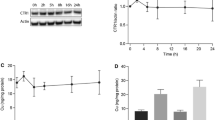Abstract
Purpose
The aim of this study is to examine the factors affecting sensitivity to cisplatin, carboplatin, and oxaliplatin in human colorectal tumor cell lines.
Methods
Caco-2, DLD-1, HCT-15, HCT116, LS180, SW620, and WiDr cells were used. Their growth inhibition by platinum derivatives was evaluated with a WST-1 assay utilizing succinate dehydrogenase activity. Cellular accumulation and DNA-binding of platinum were measured with an inductively coupled plasma mass spectrometer. The mRNA levels of copper transporters (hCtr1, ATP7A, and ATP7B) and organic cation transporters (hOCT1, hOCT2, and hOCT3) were evaluated by the real-time reverse transcription-PCR method using SYBR® green.
Results
The cytotoxicity of platinum derivatives ranked oxaliplatin > cisplatin > carboplatin in almost all cells used. Cellular accumulation and DNA-binding of platinum varied among the types of cells, but levels were similar on treatment with cisplatin and oxaliplatin, and lower in response to carboplatin. The levels of copper and organic cation transporter mRNAs also differed with cell type. A correlation analysis revealed that sensitivity to platinum derivatives was dependent in part on the amount of platinum bound to DNA. In addition, the cellular accumulation of platinum and level of ATP7A mRNA may be factors affecting the cytotoxicity of cisplatin, while the cytotoxicity of oxaliplatin was suggested to be affected by the levels of ATP7A and hOCT1 mRNAs.
Conclusion
Some factors affecting the sensitivity of tumor cells to platinum derivatives were proposed, and will provide useful information for cancer chemotherapy with platinum derivatives.




Similar content being viewed by others
References
Ho YP, Au-Yeung SC, To KK (2003) Platinum-based anticancer agents: innovative design strategies and biological perspectives. Med Res Rev 23(5):633–655
Hartmann JT, Lipp HP (2003) Toxicity of platinum compounds. Expert Opin Pharmacother 4(6):889–901
Yonezawa A, Masuda S, Yokoo S, Katsura T, Inui K (2006) Cisplatin and oxaliplatin, but not carboplatin and nedaplatin, are substrates for human organic cation transporters (SLC22A1–3 and multidrug and toxin extrusion family). J Pharmacol Exp Ther 319(2):879–886
Armand JP, Bolgie V, Raymond E, Fizazi K, Faivre S, Ducreux M (2000) Oxaliplatin in colorectal cancer: an overview. Semin Oncol 27(Suppl 10):96–104
Kidani Y, Noji M, Tashiro T (1980) Antitumor activity of platinum (II) complexes of 1,2-diaminocyclohexane isomers. Gann 71(5):637–643
Wang D, Lippard SJ (2005) Cellular processing of platinum anticancer drugs. Nat Rev Drug Discov 4(4):307–320
Boulikas T, Vougiouka M (2004) Recent clinical trials using cisplatin, carboplatin and their combination chemotherapy drugs. Oncol Rep 11(3):559–595
Takara K, Sakaeda T, Yagami T, Kobayashi H, Ohmoto N, Horinouchi M, Nishiguchi K, Okumura K (2002) Cytotoxic effects of 27 anticancer drugs in HeLa and MDR1-overexpressing derivative cell lines. Biol Pharm Bull 25(6):771–778
Takara K, Obata Y, Yoshikawa E, Kitada N, Sakaeda T, Ohnishi N, Yokoyama T (2006) Molecular changes to HeLa cells on continuous exposure to cisplatin or paclitaxel. Cancer Chemother Pharmacol 58(6):785–793
Nagasawa K, Ito S, Kakuda T, Nagai K, Tamai I, Tsuji A, Fujimoto S (2005) Transport mechanism for aluminum citrate at the blood–brain barrier: kinetic evidence implies involvement of system Xc− in immortalized rat brain endothelial cells. Toxicol Lett 155(2):289–296
Lowry OH, Rosebrough NJ, Farr AL, Randall RJ (1951) Protein measurement with the folin phenol reagent. J Biol Chem 193(1):265–275
Seithel A, Karlsson J, Hilgendorf C, Bjorquist A, Ungell AL (2006) Variability in mRNA expression of ABC- and SLC-transporters in human intestinal cells: comparison between human segments and Caco-2 cells. Eur J Pharm Sci 28(4):291–299
Rixe O, Ortuzar W, Alvarez M, Parker R, Reed E, Paull K, Fojo T (1996) Oxaliplatin, tetraplatin, cisplatin, and carboplatin: spectrum of activity in drug-resistant cell lines and in the cell lines of the National Cancer Institute’s Anticancer Drug Screen panel. Biochem Pharmacol 52(12):1855–1865
Kitada N, Takara K, Tsujimoto M, Sakaeda T, Ohnishi N, Yokoyama T (2007) Effects of platinum derivatives on the function and expression of P-glycoprotein/MDR1 in LLC-PK1 cells: in case of carboplatin and nedaplatin. J Cancer Mol 3(1):23–28
Safaei R (2006) Role of copper transporters in the uptake and efflux of platinum containing drugs. Cancer Lett 234(1):34–39
Lin X, Okuda T, Holzer AK, Howell SB (2002) The copper transporter CTR1 regulates cisplatin uptake in Saccharomyces cerevisiae. Mol Pharmacol 62(5):1154–1159
Samimi G, Safaei R, Katano K, Holzer AK, Rochdi M, Tomioka M, Godman M, Howell SB (2004) Increased expression of the copper efflux transporter ATP7A mediates resistance to cisplatin, carboplatin, and oxaliplatin in ovarian cancer cells. Clin Cancer Res 10(14):4661–4669
Holzer AK, Manorek GH, Howell SB (2006) Contribution of the major copper influx transporter CTR1 to the cellular accumulation of cisplatin, carboplatin, and oxaliplatin. Mol Pharmacol 70(4):1390–1394
Sharp SY, O’Neill CF, Rogers P, Boxall FE, Kelland LR (2002) Retention of activity by the new generation platinum agent AMD0473 in four human tumour cell lines possessing acquired resistance to oxaliplatin. Eur J Cancer 38(17):2309–2315
Samimi G, Varki NM, Wilczynski S, Safaei R, Alberts DS, Howell SB (2003) Increase in expression of the copper transporter ATP7A during platinum drug-based treatment is associated with poor survival in ovarian cancer patients. Clin Cancer Res 9(16 Pt 1):5853–5859
Samimi G, Katano K, Holzer AK, Safaei R, Howell SB (2004) Modulation of the cellular pharmacology of cisplatin and its analogs by the copper exports ATP7A and ATP7B. Mol Pharmacol 66(1):25–32
Zhang S, Lovejoy KS, Shima JE, Lagpacan LL, Shu Y, Lapuk A, Chen Y, Komori T, Gray JW, Chen X, Lippard SJ, Giacomini KM (2006) Organic cation transporters are determinants of oxaliplatin cytotoxicity. Cancer Res 66(17):8847–8857
Acknowledgments
The authors are grateful to Associate Professor Kazuki Nagasawa, Ph.D. (Department of Environmental Biochemistry, Kyoto Pharmaceutical University) for technical advice. This work was supported in part by a Matching Fund Subsidy for Private Universities from the Ministry of Education, Culture, Sports, Science and Technology of Japan.
Author information
Authors and Affiliations
Corresponding author
Rights and permissions
About this article
Cite this article
Kitada, N., Takara, K., Minegaki, T. et al. Factors affecting sensitivity to antitumor platinum derivatives of human colorectal tumor cell lines. Cancer Chemother Pharmacol 62, 577–584 (2008). https://doi.org/10.1007/s00280-007-0640-3
Received:
Accepted:
Published:
Issue Date:
DOI: https://doi.org/10.1007/s00280-007-0640-3




